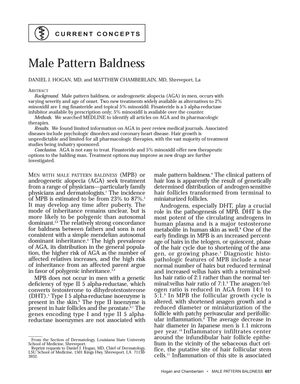Male Pattern Baldness: Psychological Impact, Disease Association, and Treatment Options
July 2000
in “
Southern Medical Journal
”

TLDR Male pattern baldness is often genetic and linked to a hormone, with treatments like finasteride and minoxidil being effective for some men.
The 2000 document reviewed male pattern baldness (MPB), or androgenetic alopecia (AGA), highlighting its psychological impact and association with diseases like coronary heart disease. It was found that AGA is likely polygenic and involves the transformation of hair follicles influenced by dihydrotestosterone (DHT). The Hamilton-Norwood scale is used for classifying AGA severity. Treatment options include finasteride and minoxidil, which have shown some effectiveness. Specifically, a study showed that 1 mg of finasteride daily resulted in a significant increase in scalp hair count in 66% of men after 24 months, and 42% showed visible regrowth in the anterior mid-scalp area. Biopsy results indicated a reversal of hair miniaturization. However, finasteride was not effective for postmenopausal women. Combination therapy with finasteride and minoxidil showed improvement in one case from MPB Hamilton stage V to stage III in 12 months. The document concludes that while these therapies offer hope, results vary and take time, with new treatments targeting different enzymes and receptors under investigation.





